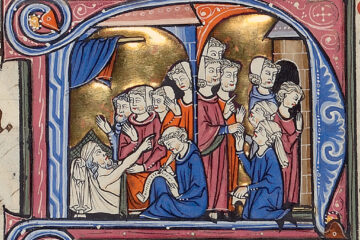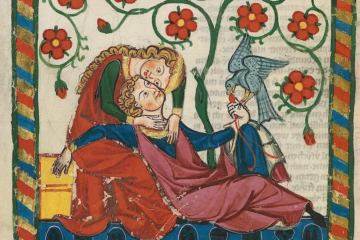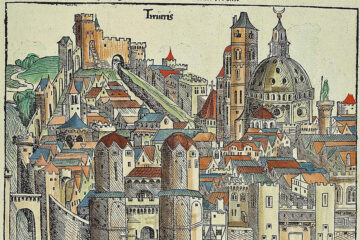Christianity is one of the strongest opponents of slavery. This is, at least, in theory. The reality is much darker. The Holy See banned the practice of slavery during the Council of Rosewood in 1087 in their IV Canon. However, Catholic rulers rarely adhere perfectly to these restrictions and the ban on slavery is no exception.
The French Legal Code makes no mention of slavery in it and goes so far as to describe a form of legal servitude that is to be practiced normally throughout the realm. There have been Voices in the Parliament that demand a law be implemented which would regulate the status of slavery in France. So far, the Mediterranean slave trade is alive and well and some French lords profit off of it and are major importers of slaves for the powerful and wealthy few of the Kingdom. The Polignacs, the Noble House of the Duchy of High Provence, came to power because of their connections to the slavelords of the Italian merchant republics. The ports of southern France are ripe with slaves from all over the Mediterranean and even farther.
There are dozens of slaver families that contribute to the Mediterranean slave trade. The most powerful are from Genoa, Venice, and Ragusa. They command entire fleets dedicated to the purchase and acquisition of slaves from foreign lands, and their subsequent transport to Italy and the rest of Europe. Besides the Italian slavers, the other, and likely more dangerous group, are the pirates who roam the waters of the Mediterranean in search of unprotected transport/merchant ships. While most of the slaves of the Italian families come from war captives or those sold into slavery due to debts, the pirates enslave freemen and freewomen of all backgrounds, cultures, and religions.
The most prolific purchasers of slaves are the wealthy and powerful families of the Duchy of Aragon and the Principality of Catalonia. These coastal powers require obscene amounts of slaves every year to fuel their naval might and grow their armies while fighting the Muslims in Iberia. The Kingdom of Portugal is no different. In Italia, the de Hauntevilles’ Sicily has become a hub for slavery, both the sale and purchase of them. Slaves are very cheap on this island, with even some city families owning a slave which they can show off as a symbol of their power. Across the sea, the Kingdom of Jerusalem controls key cities that export Jewish, Muslim, and even Catholic slaves to the rest of the Mediterranean. As the number of Muslim refugees fleeing the Mongol horde grows, so does Jerusalem’s slave empire. However, the rest of the Muslim realms do not take kindly to the enslavement of their brethren. They can be placated with promises and gold only for so long. The Roman Empire and its capital of Constantinople are the centers of the Mediterranean slave trade. It is said that a wealthy man in Constantinople can buy a slave from every corner of the world. The Empress is said to own hundreds of her own slaves which tend to her palace and some even offer political counsel. The Mongols’ arrival in Europe shifted the slave trade as well. Slaves from the Balkans, the Near East, and the Ruslands were being captured, transported, and then sold on the markets of Novgorod which sits at the heart of the Mongol slave trade. They do good business with the Scandinavians who often purchase pagan and Slavic slaves from the Mongols. Meanwhile, any skilled or educated workers that end up in Novgorod are destined to be bound for the Mongol capital and their key border holdings where they will be put to use defending and developing the Empire. Surprisingly enough, there have been many stories of slaves becoming popular among the Mongol elite and even rising to command some form of authority.
If you are looking to break into the business of slavery, there is an abundance of sources. The bulk of the Mediterranean slave trade is made up of captured Muslims from Iberia and the Near East. These are men who were captured after battle or siege, along with their women and children. The Jews who failed to flee deep into Europe are often hunted, captured, and sold to slavers by local lords or mercenaries. Sometimes, powerful men will choose to rid themselves of Jewish moneylending groups not by paying off their debts to them, but by kidnapping them and shipping them off to the Mongols or to Catalonia. The English are common slaves in Bretonia, France, and the Scandinavian kingdoms. Since they are heretics, there is no law protecting them from the institution of slavery. Wealthy and adventurous youths will often form raiding parties to scour the English coasts and raid their smaller settlements for slaves and plunder, mimicking the Vikings of old. However, Vikings are known to raid the north of the British Isles for fresh slaves a few times every year. Slaver ships are plentiful on the Volga, going to and from Novgorod. the most popular slaves here are the pagans of Eastern Europe. Old Slavs, Cumans, Tatars, and others learn that they will never be free again once they set sail down the icy waters of the Volga. The Balkans are no different. Not long ago, they were a prime source of slaves due to their pagan traditions. However, since their conversion, fewer and fewer are being sold into slavery. Although, the Roman Empire does not seem to mind that so many of their slaves are Balkan-born Christians. The Romans also go to great lengths to enslave any Turks they defeat in battle. Jerusalem and Constantinople have a large population of Gypsy slaves as well, sold as entertainers all across Europe. As much as Europeans love enslaving each other, they also love overreaching far beyond their sphere of influence. Lisbon is a key center of the Sub-Saharan slave trade, with a population said to be 1/10 dark-skinned. Trebizond, Constantinople, Baghdad, Alexandria, Tunis, and even Venice boast of having men and women made slaves from the lands of the Mongols and the Far East.
The most costly slaves are European men and women. Men must be fit, while women must be beautiful. Children are evaluated, depending on their gender, age, health, and stock, and can even be more expensive than grown men. Darker-skinned men and women cost less and are often bought to be house servants. Those from exotic lands can be priced higher. They are kept and paraded as decorations for their wealthy masters. Women cost more if they are with child since they carry another slave in them, but more importantly, they can fill the role of a wet nurse. Marked women, those scarred or tattooed are valued the least, usually sold as cheap labor or poor stock. Virgin women are very expensive, with the price scaling depending on their age, health, place of origin, and beauty. The elderly and sick are often considered failed stock or bad investments and will be sold for next to nothing or even thrown overboard to save resources. Slaves can be used for a variety of different purposes. Most are laborers, working the fields, forests, and shores of their masters. They can, however, be specialized. The Catalan and Aragonese nobility often purchase young Muslim men and train them to become warrior slaves who are baptized and taught to fight in their armies against their former brethren. Most women end up in sex slavery, bound to large and powerful noble families. Slaves who know a craft are considered skilled slaves and are often sent into urban centers and even larger villages to serve their masters there, sometimes even acting as mentors. Educated slaves are very expensive. These are men and women who have been given a proper education. They are literate, sometimes multilingual, educated on specific topics, and make for good diplomats and advisors.
By Church Law, no Christian may ever enslave another Christian. This rule does not work in practice. While you won’t see a Frenchman enslaved by another Frenchman, you can see Slavs as slaves, even though they were baptized at birth like any other Christian child. The Germans took French slaves after the Fifty Years’ War, sometimes slavers simply target the poor and defenseless. Coastal settlements are the most dangerous ones to live in if you have no way to protect yourself as slavers can easily port, scout the area out, take who they please, and leave to sell them leagues away from home.
There are times when a relative of a powerful or wealthy person is captured and enslaved. Since these are their main source of income, slavers will return their family members free of charge. The crux of the issue is that you have to react fast enough before they lose track of their stock. If you are powerful in your own right, then you can contact these slaver companies and request your family back.
The purchase of slaves is done almost exclusively by the aristocracy and wealthy individuals. The cost of a single slave could reach the yearly earnings of a common freeman. Consequently, having one or multiple slaves is a sign of power, which is why those who have a legion of them are easily recognizable as people you don’t want to anger or trifle with.
The life of a slave depends on the reason why they were bought, the place they are shipped to, and most importantly, the temperament of their master. There are slaves that live envious lives, with freemen ready to trade their stations for theirs. However, the vast majority of times there is nothing to envy in a slave’s life. Lodgings are provided by the master, usually decrepit and cramped. There is work to be done and because of their station that meant work for most of the day and work left unpaid. Instead, their master allows them to live and provides them with simple food and water to live off of. Slaves can’t marry or hold any titles. Their rights are not protected by any law or document. For all intents and purposes, they have the same rights a hammer would, for they are no more than tools, property, for their masters.
The Church is not blind to this obvious transgression. As powerful as they are, they cannot act against slavery until it is sufficiently weakened. Instead, the Church promotes the practice of manumission upon death. It is tradition for a Catholic slaveowner to manumit (release) all of their slaves on their deathbed. This is the one hope of slaves; one day, their master will die and either they or their children may live to see freedom again. The reality is that even after they are freed, most of these slaves will then remain with their slaveowner’s families since they are not the most employable group of people. They will be paid for their work, but still, less than any freeman or freewoman would.
There are those who justify the practice of slavery by quoting the Bible and citing the Curse of Ham as evidence of God’s support for the tradition. Regardless of the Bible, Abrahamic scholars justify slavery by promoting it mostly against pagans, heretics, and heathens. The enemy of the faith is free to be perpetually subjugated. There is such a thing as Just Enslavement which comes about as the result of conquests. It is backed by natural law, that the strong may rule the weak. Whatever the justification, most are shrewd enough to see that the real reason slavery is still around is that it is more profitable than any other system in place in Europe. Slaves are a large investment, but in the long term, they stand to triple what they were worth originally.
One of the biggest opponents of slavery are city guilds. This is not out of some secret altruism or empathy. Trade guilds hold monopolies in cities and towns, meaning they set the prices, wages, and quality of products. Were a wealthy artisan to leave the guild and purchase slaves, he could keep the quality of the guild but sell his wares at half of the price because he doesn’t pay for labor, ruining the guild’s influence in urban centers. Additionally, guilds also like to keep trade secrets which they don’t even share with neighboring towns. They fear that skilled slaves might learn these trade secrets and then spread them once they are free or escaped.
One of the biggest dangers of having a large slave population are the servile revolts that often accompany them. If the conditions of their existence are dire enough, slaves realize that they have little else to lose except their lives. These desperate slaves rise up and can even occupy entire sections of towns/cities during their revolts. It is a hassle for local lords to put these rebellions down so most slave ports make sure to hold their centers to specific standards in an attempt to prevent conditions from deteriorating to the point of no return.
Slavery in France in 1223 is a controversial issue. It is something that is frowned upon in Rosewood and the north in general. The south, however, is not against it, with some even advocating for it. Powerful families have reached the parliament exactly because of their slave hosts, so they would not like to see the institution regulated or abolished. The Parliament is said to discuss this issue in the future, but many warn that total abolition could lead to open war with the southern provinces, those like High Provence who hold a share of the Mediterranean slave trade.


